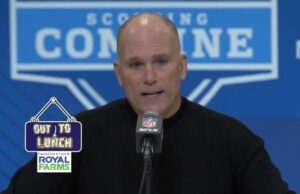Earlier today, ESPN’s Adam Schefter reported that the Ravens were parting ways with Free Safety Earl Thomas after just one season with the team. Schefter also reported that the Ravens would try to trade Thomas and if they couldn’t find a trade partner, the Ravens were prepared to release Thomas.
The Ravens have since announced that they have released Earl Thomas for “personal conduct that has adversely affected the Baltimore Ravens”. This language is specifically worded to indicate that the team intends to void the guarantee of Thomas’ $10M base salary.
Plenty has been reported about what led up to the Ravens’ decision, so there’s no reason to belabor that here, other than to say that those details will be the crux of the team’s argument for voiding Thomas’ guaranteed base salary.
So, on to the Salary Cap implications:
CONTRACT DETAILS:
Last Spring, Thomas signed a 4-year, $55M deal with the Ravens that included a $20M Signing Bonus and $32M in fully guaranteed money. His 2020 Cap number is $15M, which consists of his $10M fully guaranteed base salary and the $5M 2020 bonus proration from his $20M Signing Bonus.
[Related Article: Earl Thomas, The Final Straw]
CAP IMPLICATIONS:
Due to his $20M Signing Bonus, Thomas will – no matter what – have Cap charges of at least $5M in 2020 and $10M in 2021. These are the yearly bonus prorations from his Signing Bonus. Since Thomas’ deal was for 4 years, his Signing Bonus is divided by those years and his Signing Bonus then counts $5M in each of those years. Since Thomas is being released after June 1st, only his 2020 bonus proration counts towards the 2020 Cap and the 2021 and 2022 prorations will count as dead money against the 2021 Cap. Had Thomas been released prior to June 1st, the entire $15M would have counted against the 2020 Cap.
If the Ravens were not seeking to void the $10M guaranteed base salary, the Ravens would be taking a hit of $15M in dead money ($5M bonus proration and $10M guaranteed salary) on their 2020 Cap. This would then basically be a wash, since his Cap number was set to be $15M. Obviously, if they are unsuccessful in setting aside the guarantees, this is ultimately what they will have to account for.
So, given that the Ravens have signaled that they are going to void the guarantees to Thomas’ base salary, the Ravens will initially receive a $10M savings by the removal of the guaranteed base salary. Thomas would then only count $5M against the team’s 2020 Cap (his 2020 bonus proration).
But, that’s only the beginning of the maneuvering, as it seems certain that Thomas and the NFLPA will be filing a grievance.
GRIEVANCE IMPLICATIONS:
Right off the bat, for whatever reason, NFL grievances don’t happen very quickly, so it’s very possible that this issue won’t be resolved until after the season. For example, while the COVID pandemic likely added some to the delay, Antonio Brown’s grievance against the Patriots was filed last October and was just settled last month and his grievance against the Raiders is still pending.
Once Thomas files a grievance, there are immediate Salary Cap implications. Under the terms of the league’s CBA, 40% of the amount claimed in the grievance immediately counts against the team’s Cap. So, while the $10M salary is immediately removed from the Ravens’ Cap by virtue of the team voiding his guaranteed salary, the grievance will return $4M to the Cap.
If the Ravens are successful and prevail in the grievance, that $4M will be returned to their Cap, either this year or next, but if Thomas prevails, the Ravens will get hit with an additional $6M Cap charge at that time (subject to offsets explained below).
Of course, the team and Thomas could potentially settle the dispute at some point, which depending on the amount would impact the team’s Cap in one direction or the other.
OFFSETS:
According to Tom Pelissero of the NFL Network, Thomas’ contract contains offset language, so whatever he earns in base salary this year from his new team, that amount will offset the grievance amount.
Worth noting: Earl Thomas’ contract contains offset language, so whatever he earns with his next team would be deducted from his #Ravens guarantee and reduce the amount challenged in a grievance. The team would carry 40% of the grievance amount on its cap.
— Tom Pelissero (@TomPelissero) August 23, 2020
So, for example, if Thomas signs with the Cowboys and receives a $5M base salary from the Cowboys, the grievance amount would be reduced by $5M, but until it’s actually earned (i.e., by the end of the season), he would still count $4M against the Ravens’ Cap. So, while the offset would eventually reduce the grievance amount, it will not have any immediate impact on the Ravens’ Cap.
UPDATE (4:40PM, 8/23): Russell Street Report has learned that Thomas’s contract contains significant offset language that would seem to include all compensation received, not just base salary – and not only in 2020, but also over what would have been the 3 remaining years of his deal with the Ravens. This would seemingly mean that if Thomas earns $10M at some point over the next 3 seasons, the Ravens would not be required to honor the guarantee. So, conceivably, the Ravens could lose the grievance, but still not be obligated to pay the $10M (or would be reimbursed by Thomas).
BOTTOM LINE:
The bottom line with the situation is that there isn’t going to be a quick resolution. The Ravens have released Thomas and voided his $10M guaranteed base salary. Thomas will file a grievance and the Ravens will carry the $4M grievance Cap charge (along with the $5M bonus proration). Since it’s unlikely that the grievance will be heard until 2021, Thomas will count $9M on the team’s Salary Cap, so the Ravens will realize $6M in Cap savings for 2020. However, they may have to account for more in the future if Earl Thomas wins the grievance.
Prior to Thomas’ release, the Ravens had just under $7M in Salary Cap space. With Thomas’ release and the expected grievance, that will become just under $13M (although, it will initially be $17M, prior to the grievance being filed).









